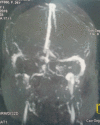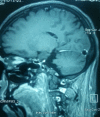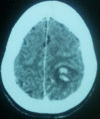[Clinical and therapeutic aspects of post-partum cerebral thrombophlebites]
- PMID: 28293364
- PMCID: PMC5337296
- DOI: 10.11604/pamj.2016.25.248.9576
[Clinical and therapeutic aspects of post-partum cerebral thrombophlebites]
Abstract
Cerebral thrombophlebites are rare but life-threatening conditions (1/5000 births). Pregnancy and postpartum are predisposing factors: clinical presentation vary and may be misleading, dominated by headaches, convulsions and neurological deficits but showing no specific features. Physical examination often generates informations unavailable and misleading because cerebral thrombophlebites share symptoms with other affections. A definitive diagnosis can be made only neuroradiologically. Brain MRI is currently the reference method; it allows visualization of the venous thrombus and its evolution. The treatment of cerebral thrombophlebites is essentially medical based on anticoagulant drugs. We here report four cases with post partum cerebral thrombophlebites. The aim of our study and review of the literature is to highlight the importance of early diagnosis and adequate therapy.
Les thrombophlébites cérébrales sont des pathologies rares (1/5000 naissances) mais redoutables. La grossesse et le post-partum en sont des circonstances favorisantes: leur symptomatologie clinique est divertie et variée dominée par les céphalées, les convulsions et les déficits neurologiques mais aucun signes n’est spécifique. L’examen physique est souvent pauvre et prêt à confusion avec de nombreuses autres affections. Le diagnostic de certitude ne peut être que neuroradiologique. L’IRM cérébrale est actuellement la méthode de référence, elle permet la visualisation du thrombus veineux et le suivie de son évolution. Le traitement de ces TPC est essentiellement médical basé sur les anticoagulants. A l’occasion de quatre observations de TPC, du post-partum et d’une revue de la littérature, nous allons mettre le point sur l’importance d’un diagnostic précoce et d’une prise en charge thérapeutique adéquate.
Keywords: Cerebral thrombophlebites; brain MRI; convulsion; heparin therapy; postpartum.
Conflict of interest statement
Les auteurs ne déclarent aucun conflit d'intérêt.
Figures



References
-
- Arquizan C. Thrombophlébites cérébrales: aspects cliniques, diagnostic et traitement. Réanimation. 2001;10(1):383–92.
-
- Aissi M, Boughammoura-Bouatay A, Frih-Ayed M. Thrombophlébite cérébrale au cours de la grossesse. Gynécologie Obstétrique & Fertilité. 2016;44(2):129–131. - PubMed
-
- Shah M, Agarwal N, Gala NB, Prestigiacomo CJ, Gandhi CD. Management of dural venous sinus thrombosis in pregnancy. European Journal of Vascular and Endovascular Surgery. 2014;48(4):482–484.
-
- Ameri A, Bousser MG. Cerebral venous thrombosis. Neurol Clin. 1992;10(2):87–111. - PubMed
-
- Tehindrazanarivelo A, Evrard S, Schaison M, et al. Prospective study of cerebral sinus venous thrombosis in patients presenting with benign intracranial hypertension. Cerebrovasc Dis. 1992;2(1):22–7.
Publication types
MeSH terms
Substances
LinkOut - more resources
Full Text Sources
Other Literature Sources
Medical
